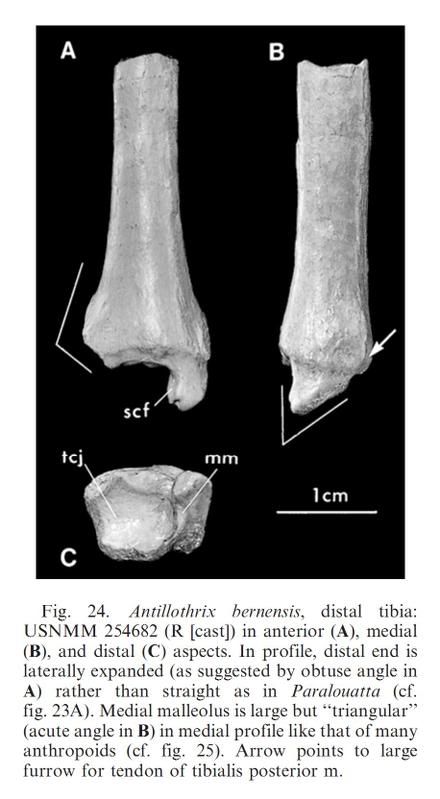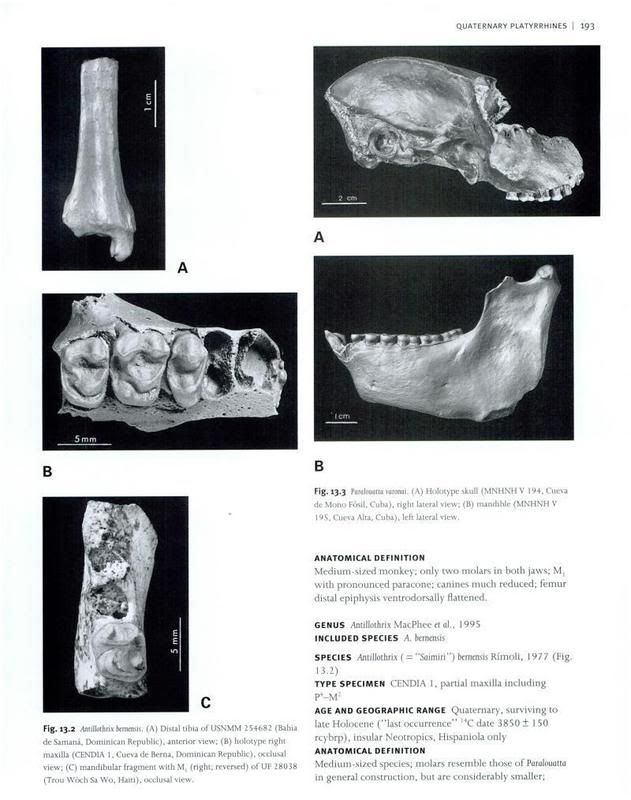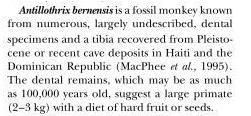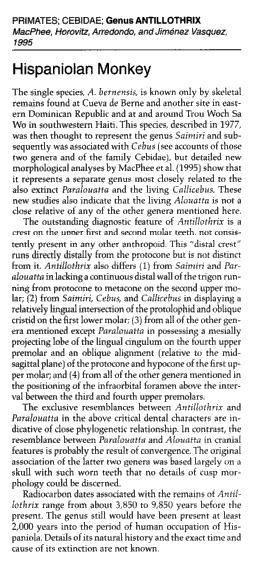|
|
Post by Melanie on Nov 16, 2007 18:34:59 GMT
|
|
|
|
Post by another specialist on Nov 17, 2007 19:52:39 GMT
We describe recently recovered dental and mandibular remains of the Cuban platyrrhine Paralouatta varonai, previously known from the holotype only (a nearly complete skull with very worn teeth). We also expand on the original description of the type specimen. Paralouatta is one of three extinct taxa of Greater Antillean Quaternary monkeys known from craniodental remains. The other two, Xenothrix mcgregori and Antillothrix bernensis, occurred in Jamaica and Hispaniola, respectively. It has been common practice to assume that Antillean monkeys were more closely related to individual mainland taxa than to each other. Thus, P. varonai was thought to be related to Alouatta; Antillothrix bernensis to Saimiri or Cebus; and X. mcgregori to Callicebus, or to callitrichines, or even to be of unknown affinity. With the discovery of well-preserved dental remains of Paralouatta, it can now be ascertained that this species was in fact very different from Alouatta. Cladistic analysis reveals a sister-group relationship between Antillothrix and Paralouatta, followed on the cladogram by Xenothrix and Callicebus (last taxon being the closest mainlaind relative of the Antillean clade). This conclusion has an important biogeographic implication: recognition of an Antillean clade, as advocated here, assumes only one primate colonization from the South American mainland, not several as previously believed. Copyright 1999 Academic Press www.ingentaconnect.com/content/ap/hu/1999/00000036/00000001/art00259 |
|
|
|
Post by another specialist on Jun 22, 2008 15:42:13 GMT
A new fossil cebine from hispaniola R. D. E. MaCphee 1, C. A. Woods 2 1Department of Anatomy, Duke University Medical Center, Durham, North Carolina 27710 2Department of Natural Sciences, Florida State Museum, Gainesville, Florida 32611 Keywords Primate evolution • Platyrrhini • Cebinae • Systematics Abstract An incomplete mandibular fragment of a cebine monkey from an early Holocene Haitian cave deposit adds to the small but growing list of fossil Antillean primates. The jaw is of the correct size to belong to the same taxon as the partial maxilla of Saimiri bernensis from the Dominican Republic. Both finds probably represent a single species whose proximate ancestry lay closer to Cebus than to Saimiri, although more evidence will be required to substantiate this. No close relationship of the Hispaniolan fossils to the Jamaican platyrrhine Xenothrix is indicated. How monkeys managed to penetrate the West Indies is a biogeographical puzzle of the first order. Geographical vicariance events, island-hopping, and purposeful or inadvertent introduction by humans seem rather implausible devices. On the whole, long-distance, over-water rafting from the Americas remains the most likely mechanism for past land vertebrate immigration into the Caribbean. www3.interscience.wiley.com/journal/110483153/abstract?CRETRY=1&SRETRY=0 |
|
|
|
Post by another specialist on Jun 22, 2008 15:44:08 GMT
The Hispaniola Monkey (Antillothrix bernensis) is an extinct primate found on the island of Hispaniola. The species is thought to have gone extinct around the 16th century. The exact timing and cause of the extinction are unclear, but it is likely related to the settlement of Hispaniola by the Europeans in 1492 after discovery by Christopher Columbus. At first, the Hispaniola Monkey was thought to be a close relative of the Capuchin monkeys, but later investigation showed that the similarities were due to convergent development. Horovitz and MacPhee[1] developed the hypothesis, first proposed by MacPhee et al.[2], that all the Antillean monkeys (the others being the two Cuban monkey species of genus Paralouatta and Xenothrix mcgregori of Jamaica) belonged to a monophyletic group linked most closely with modern Callicebus. They later assigned the Antillean monkeys to the tribe Xenotrichini[3] – the sister group of the tribe Callicebini with extensive anatomical comparisons and by extending their parsimony analysis using PAUP*.[4] They maintained that the monophyly of the Antillean monkeys was still supported in the most parsimonious trees, but in slightly less parsimonious trees, Aotus did appeared to be linked with Xenothrix. . en.wikipedia.org/wiki/Hispaniola_Monkey |
|
|
|
Post by another specialist on Jul 12, 2008 5:59:05 GMT
|
|
|
|
Post by another specialist on Jul 12, 2008 6:12:59 GMT
from above  |
|
|
|
Post by another specialist on Jul 30, 2008 19:42:55 GMT
 The Primate Fossil Record By Walter Carl Hartwig |
|
|
|
Post by another specialist on Jul 31, 2008 12:21:41 GMT
 Primate Adaptation and Evolution By John G. Fleagle |
|
|
|
Post by another specialist on Jul 31, 2008 12:50:56 GMT
 Walker's Primates of the World By Ronald M. Nowak, Ernest Pillsbury Walker, Russell A. Mittermeier, William R. Konstant, Anthony B. Rylands |
|
|
|
Post by surroundx on May 6, 2015 12:43:10 GMT
|
|
|
|
Post by surroundx on May 6, 2015 14:06:23 GMT
|
|
|
|
Post by Melanie on Sept 13, 2015 11:22:59 GMT
|
|
|
|
Post by Melanie on Sept 13, 2015 11:25:29 GMT
Journal of Human Evolution Available online 29 August 2015 In Press, Corrected Proof — Note to users 1.32 ± 0.11 Ma age for underwater remains constrain antiquity and longevity of the Dominican primate Antillothrix bernensis Alfred L. Rosenbergera, b, c, d, Robyn Pickeringe, , , Helen Greene, Siobhán B. Cookef, g, Melissa Tallmang, h, Andrea Morrowi, j, Renato Rímolik, l www.sciencedirect.com/science/article/pii/S0047248415001517 |
|
|
|
Post by Sebbe on Oct 24, 2015 11:07:41 GMT
|
|
|
|
Post by surroundx on Apr 11, 2017 13:08:05 GMT
Halenar, Lauren B., Cooke, Siobhán B., Rosenberger, Alfred L. and Rímoli, Renato. (2017). New cranium of the endemic Caribbean platyrrhine, Antillothrix bernensis, from La Altagracia Province, Dominican Republic. Journal of Human Evolution 106: 133-153. [ Abstract] |
|
|
|
Post by surroundx on Jul 14, 2019 9:23:16 GMT
Klukkert, Zachary S. et al. (2019). Newly-discovered craniomandibular remains preserve the first known incisors of the extinct Dominican monkey Antillothrix bernensis. The FASEB Journal 33(1): 612.4. [ Abstract] |
|